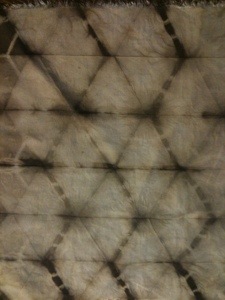Month: December 2012
The Alchemy of Natural Dyeing
Throughout the summer we plucked the flowers off our African and pot marigolds, coreopsis, dahlias and other dye plants. Even after weeks of doing this, we ended up with ounces, rather than pounds of flower heads but they were enough to produce the magic.
Recently I spent an evening with Liz, MA student at the London College of Fashion, who’s been my dye guru, at her flat in Hackney. One of my abiding images is of a saucepan full of flower heads being heated up and watching the colour leech from the flowers into the water making a toffee orange liquid.
Flowers are surprisingly simple to dye with (unlike woad and indigo which involve fermentation and deoxygenation). Put them in the water, usually the same weight of flowers to material, heat up the water (but don’t boil) and then put your material (in our case, alum-mordanted silk) in. Leave it for an hour or up to two days. Of course, you are bound too impatient to wait forty-eight hours so are likely to pull out the cloth before it’s at its strongest but you can take it out, have a peek into the folds and then put it back.
We used a basic itajime method of folding the material. The simplest shape is a concertina fold but Liz got quite good at isoceles triangles and squares. The dye colours the exposed edges. The sharper the fold, the more sophisticated the look. Less tie-dyed.



Most flower dyes end up yellow, but there is a huge and subtle variety of yellow – a shimmery gold of African marigold, a zingy lemony dahlia, a kind of apricot-y coreopsis. And then you can add things like iron or soda ash to change the colour. But that’s for another day.
After this successful evening with Liz I felt brave enough to have a go with my madder alone. I got very excited about the test sample as it was a deep brick red. Reds are rare. The result on the bigger bit of material was more orangey coral but still pretty special.






